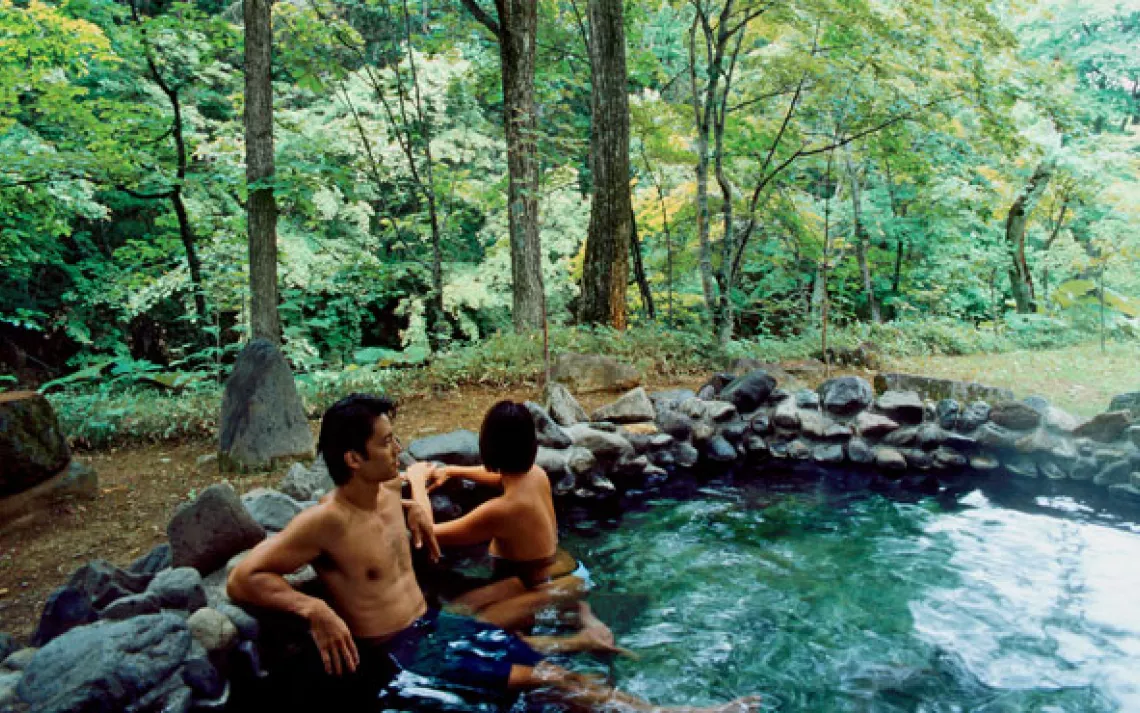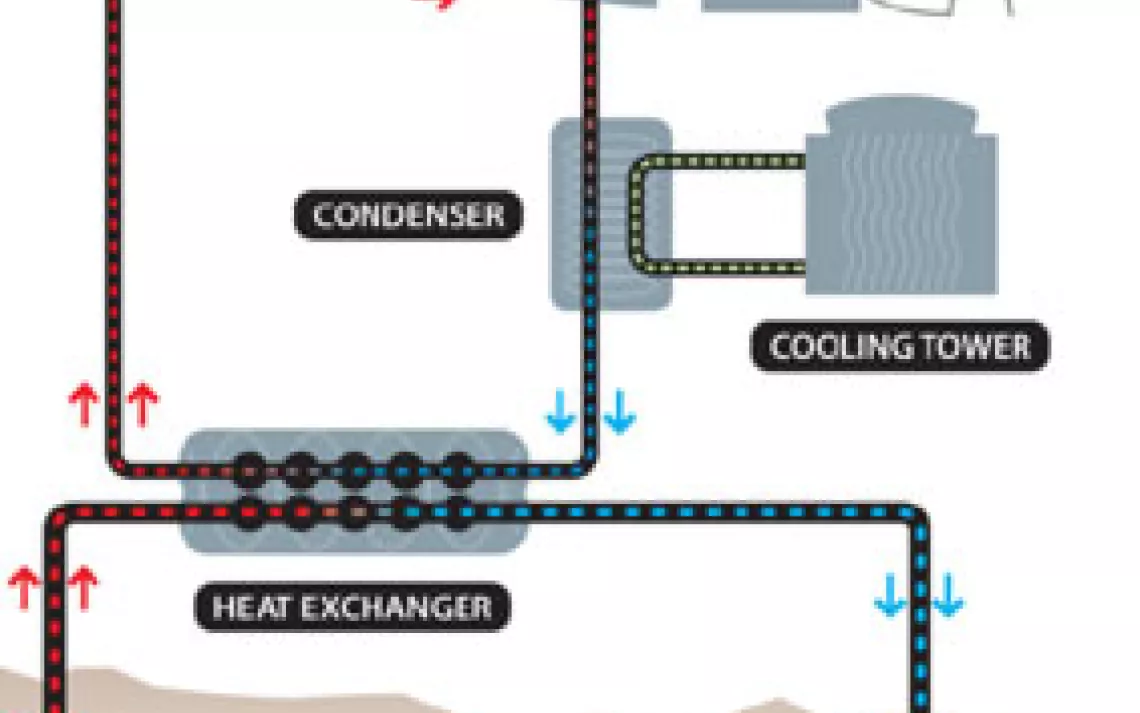Has Geothermal’s Moment Finally Arrived?
A new generation of innovators is gambling on its future

Illustration by Nicolás Ortega; 3D Rendering of sliced Earth: fpm/Getty Images
NO MATTER WHERE you stand on Earth, there is heat beneath your feet. It's closer in some places, and there's generally more of it deeper down, but it's always there, smoldering away since our planet's creation 4.5 billion years ago.
Heat is energy. In theory, there's enough of it underground to supply all of our everyday needs. Just a slice of the existing geothermal power would light up every home in the United States five times over. It's what energy people like to call "base load"—a source of power that's always on. Unlike wind and solar, geothermal produces energy day and night, rain or shine, and has a comparatively small footprint. It can be turned on when needed and turned off when other sources are more active. It doesn't generate greenhouse gas emissions, as fossil fuels do. Nor does it produce toxic waste, as nuclear does.
For decades, promises have come and gone that a game-changing breakthrough would make this unique sector of renewable energy available at scale and help move us away from planet-heating fossil fuels. There is little to show for it: Today, geothermal accounts for less than half a percent of US energy generation.
Part of the challenge is that hot spots are rare. Geothermal also has a visibility problem. We see the sun shine; we watch the wind blow through blades of grass. But aside from a hot springs resort or the alien displays in Yellowstone National Park, there's little to indicate that geothermal energy exists at all. Even in places where water boils to the surface in an eggy fog, there's no certain way of reaching an electricity-generating geothermal source.

This has long been its great paradox: Geothermal energy is everywhere and nowhere all at once.
That might be changing.
Geothermal recently got a shot in the arm courtesy of the Inflation Reduction Act. The IRA has offset the costs of installing direct-use geothermal heating systems, which college campuses and small cities like Boise, Idaho, are using to borrow heat from accessible aquifers and hot springs. Most exciting, it has spurred private investment in technologies that are pushing power-generation projects deeper than ever before.
Technical breakthroughs, government support, and new investment—this is the stuff that moves markets. Has geothermal's moment finally arrived? In October, I traveled to Reno, Nevada, where 1,500 people had gathered, hoping to answer that question.
IN 2023, the Geothermal Rising Conference returned to Reno's four-star Peppermill Resort Spa Casino. Geothermal Rising is for renewable energy enthusiasts what the American Petroleum Institute is for oil and gas suits: the oldest, most influential association of professionals in the space. Since its founding in 1972, the organization has gathered scientists, engineers, bureaucrats, and entrepreneurs for an annual meet-up to talk shop, present new research, and ink deals. As they did last year, attendees hobnobbed amid the scent of stale tobacco in a place where the sun never rises or sets.
Like all successful casinos, the Peppermill was designed to defy time. Its few windows are tinted red, and its lights are forever set to a tone that imbues the space with a suspended sense of happy hour. Maybe that's partly why it's a favorite of Geothermal Rising, which never misses an opportunity to remind conference-goers that geothermal energy is always on.
Inside, the Peppermill is a dizzying maze of marble hallways and pulsating gambling halls, with 1,635 rooms, more than 1,700 blinking electric gambling machines, 16 bars, 10 restaurants, two heated pools, and a 43,000-square-foot spa and fitness center with what is billed as northern Nevada's only "caldarium." Taking in its 107,272 square feet of throbbing consumption and entertainment shrouded in Italian decor like an Olive Garden, one could easily succumb to a pessimistic view that the fight to avert climate catastrophe has been lost. This temple to expenditure and excess is wrapped in televisions so large that I felt the heat of their screens on my skin.
But below the Peppermill, and Reno itself, is a sizable geothermal network, the result of the crust underneath ripping apart at about the same rate as your toenails growing. Since 2010, the casino has tapped into this network through several wells that bring hot water to the surface to heat the pools and spa, the water in the faucets, and the air in winter. A $9.7 million investment in a direct-use system paid for itself in less than four years.
There was also something besides cigarette smoke in the air, and after a time, I pinpointed it: optimism. The event's theme gave it a clear tip of the hat: "Geothermal Everywhere."
This has long been its great paradox: Geothermal energy is everywhere and nowhere all at once.
"The IRA is transformational legislation," said Tim Latimer, CEO of the start-up Fervo Energy. His enthusiasm is understandable. The Inflation Reduction Act provides more than just lucrative tax incentives for the near term. It commits to them for 10 years. In the past, tax breaks came with short windows that worried potential investors that geothermal projects would be left in the cold during the next round of grant giving. That complicated efforts to raise the capital needed to explore, drill, and build plants.
And there's more money. The Department of Energy and the Bipartisan Infrastructure Law have recently provided around $300 million to develop new technologies that will help the geothermal industry produce more power. That's a fraction of the $1.2 billion earmarked for carbon capture, a technology many worry is an energy-intensive distraction that won't work at scale. And it pales in comparison to the $9 billion set aside for developing a market—just a market—for clean hydrogen.
Even as geothermal rises, Latimer said, "individual companies get more funding than our entire industry." But if things keep going the way they are, that might change.
I walked the Venetian halls of the casino, past leather loafers and polished cowboy boots, through pockets of Stetsons and jokes about someone who's been around since the Pleistocene. There were geologists from Utah, well drillers from Oklahoma, chemists from China, students from Kenya, engineers from El Salvador, seismologists from Japan, investors from Houston. And they were speaking the same language: pounds per square inch, horizontal drilling, and return on investments.
At a presentation on a new drill bit, which looked like an ogre's gnarled claw, a chief researcher for Baker Hughes, one of the largest oil development companies on the planet, declared, "We all want to destroy rock. There are many ways to do it." It was standing room only.
The mix of people was a head-scratcher. Geothermal's best and brightest were mingling at their premier conference with oil and gas industry experts and executives. An Italian engineer from Houston-based SLB, formerly Schlumberger, the world's largest offshore drilling company, gave a presentation about something known as fluoroelastomers. Down the hall, a company called Stryde was selling palm-size seismic imaging probes for locating deep veins of hot water—they reminded me of the sensors in the movie Twister. Later, a representative manning a slick Halliburton booth clued me in on how Dick Cheney's old oil company is reimagining submersible pumps for extremely high heat. Here, among conversations about renewable energy—and how planet-warming gases from fossil fuels are driving the climate crisis—everyone, it seemed, was looking to companies like Halliburton for salvation. Stryde is also an example of such corporate reinvention; the company started off in oil and gas, and now much of its business is in geothermal.
At first, the cognitive dissonance left me feeling skeptical of the whole affair, but I also saw reasons for optimism. After years of covering climate change, I've lost faith that corporate and government leaders will take meaningful action in time to avert an ecological crisis. Meanwhile, as the Left and environmental groups fight for sporadic policy successes and the Right grows more intransigent than ever, global greenhouse gas emissions keep rising. But here, I sensed a genuine desire to set politics and ideology aside for a shared interest in solving a fascinating and troublesome engineering puzzle—one that has dogged the industry for a long time.
Geothermal energy got its first big boost during the energy crisis of the 1970s, when policymakers saw just how dependent the United States had become on Middle Eastern oil and wanted an alternative domestic energy source. That drove the establishment of new research and regulatory organizations. Chevron claimed to become one of the world's biggest geothermal producers in 2005 when it bought Unocal, which at that time owned many geothermal plants in Southeast Asia. For decades, geothermal generated more energy in the US than wind or solar. But the industry has always suffered and thrived in reaction to the tides of the fossil fuel market; in 2014, its share of the country's energy portfolio peaked. Then oil prices cratered, causing Chevron and other big-money oil companies to shed their geothermal assets to cut costs. Now they want back in.
Steve Krase, a bald and mustachioed engineer with a harmonica tattooed on his forearm, described a career that tracks with this history. "When I got into oil and gas, everybody was so pissed off about the Arab oil embargo because you couldn't get gas every day," he told me. "I really felt like part of my mission was to help the United States become energy independent. And now it's changed, you know, with climate change. Now I'm desperately trying to get us away from fossil fuels."
Environmentalists wince at the mention of bore sizes, well casings, and propping agents, but these tools could bring reliable and renewable energy to their homes someday.
Standing at the entrance to the Naples Ballroom was a dapper young fellow in lizard-skin boots named Tamas Csrefko. A Hungarian project engineer for Texas-based Nabors Industries, which owns 329 oil and gas drilling rigs spread across 15 countries, he said that he was still adjusting to the Houston heat. Three years ago, Nabors started an energy transition group, so Csrefko was in Reno looking for opportunities to put the company's equipment, expertise, and money behind start-ups with the next big idea. "This is how we imagine ourselves in the future," he said. He estimated that in three to five years, geothermal will receive the same amount of private equity investment as the fossil fuel industry does today.
But it's not just the money that's switching sides; the know-how is too. What had everyone around the Peppermill so jazzed was that fossil fuel executives and technicians were sharing what they know. And they know how to drill.
OUR PLANET FORMED in a cosmic whirlwind of gases and space debris that glommed together amid a storm of energy. Earth has been cooling ever since, continuously emitting 44 terawatts into the blackness of space like a rock removed from a campfire. Much of the planet's original heat remains in its core, some 4,000 miles under our feet, where solid iron reaches temperatures hotter than the surface of the sun. Another source just 20 miles down in the earth's semiliquid mantle creates about half the planet's heat with something like a nuclear reactor.
The mantle is a layer of liquid rock and iron circulating like thick molasses under extreme pressure and temperatures reaching almost 6,000°F. There, unstable radioactive isotopes are decaying, shedding electrons as they atrophy toward a stable state. When the bonds between atoms and electrons break, radiation explodes outward and converts to heat as it passes through the planet's layers.
Abundant heat is good news for all of us. It generates the magnetic field that protects our atmosphere from being blown away by solar wind. It also keeps the mantle in a liquid state, so that tectonic plates can float around the globe, crash together, and form mountains and seas, and the heat drives evolution by forcing adaptation to new conditions. Most of the time, these things happen quietly beneath us. But in places like Reno, faults have fractured through the crust, opening conduits for heat to rise toward the surface. Under the Peppermill, groundwater seeps into deep fissures where it encounters hot rock and boils back up at 170°F.
The bedrock under your house needs to be only 40°F to 70°F to warm the house with a heat pump. The city of Boise taps 177°F water to heat 6 million square feet of municipal and residential space. But generating power from the heat beneath our feet is something else entirely. The conventional way of making electricity from the earth's heat requires both an existing source of groundwater and rocks that can heat it to more than 250°F. In Sonoma County, California, the Geysers field is the world's largest geothermal power complex and has been producing energy since the 1960s by harnessing steam that blasts out of the ground at 370°F. The field is nestled between faults on the seismically chaotic Pacific Ring of Fire. Globally, geothermal hot spots concentrate like volcanoes along tectonic plate boundaries. Iceland and Japan are replete with them.
The National Oceanic and Atmospheric Administration lists 1,660 hot springs in the United States. Some are found in Appalachia, and a few are peppered around the Ozarks, but the vast majority are in the Mountain West, where the crust has buckled, creating deep cracks for water to infiltrate. Few, however, are hot enough to drive a turbine. The necessary overlap of water and extremely hot rock occurs on just 2 percent of Earth's surface; in the US, it tends to happen in places like the void of northern Nevada, hundreds of miles from the largest cities.
All of us are going about our days perched over an inexhaustible source of energy. To realize the dream of omnipresent geothermal power, we'll have to drill toward the source.
AT THE PEPPERMILL, all eyes were on a cadre of fresh drilling upstarts. Their executives sat on panel after panel, and their staff members strutted through the resort like rock stars. Many were young engineers who'd come over from oil and gas. The technology they're developing—the stuff that had everyone so excited—is essentially a repurposing of oil and gas techniques called enhanced geothermal systems, or EGS.
Thanks to Department of Energy grants and drillers fresh off Dakotan oil rigs, government-backed projects like Utah FORGE and private start-ups like Fervo are grinding thousands of feet deep to pockets of extremely hot rock, then injecting water down the holes to create geothermal springs where none previously existed. With EGS, the Department of Energy estimates that geothermal's contribution to US energy will balloon to more than 10 percent by 2050. Many attendees told me that's grossly underselling the potential.

Illustration by Nicolás Ortega; Roulette Wheel and Poker Chips: Don Mason/Getty Images
EGS is possible only because fossil fuel companies figured out how to drill horizontal wells at exceptional depths and pressure-wash hard-to-reach hydrocarbons out of shale. In other words: fracking. The geothermal world prefers to call it hydroshearing. Environmentalists wince at the mention of bore sizes, well casings, and propping agents, but these tools could bring reliable and renewable energy to their homes someday.
Any mention of EGS in Reno immediately conjured starry-eyed recollections of what Fervo did last summer way outside town in the scorched Nevada desert. The company had made headlines when it drilled two L-shaped wells 7,700 feet beneath the desert soil, which bent like straws before running another 3,200 horizontal feet through hot granite. It injected a fracking slurry under 2,300 pounds per square inch of pressure to force fractures between the two wells' bent legs. For 30 days, Fervo pumped water down one well, where it seeped into the cracks, became superheated, and then rose through the other well to produce a consistent 3.2 megawatts of electricity at the surface.
Fervo proved that EGS could produce energy outside existing geothermal fields like Geysers. It was one of the most exciting technological breakthroughs the industry had seen in a generation. But EGS technology can have unintended consequences: Hydroshearing has caused small earthquakes, and even if done thousands of feet below drinking water sources, it carries some risk (although so far unproven) of contaminating water with toxic chemicals in the propping agent. And, since some of the injected water is lost over time, it requires using more water in places where it's scarce.
Companies and researchers have been looking for a work-around. The Peppermill was littered with bright ideas and entrepreneurs who claimed to have solved some piece of that puzzle or another, but only one has proved it in the field. While the world's largest energy companies came to Reno with flashy booths adorned with bright lights and tchotchke-filled tables, none could compare to Eavor's spare, dramatic display—a lone black column rising from the center of the main hall like the obelisk from 2001: A Space Odyssey.
In 2022, the Calgary-based energy company demonstrated a novel approach to generating geothermal power in a remote patch of the New Mexico desert. Its "Eavor-Loop" method doesn't rely on fracking or hot water from underground aquifers but instead creates a closed-loop system for circulating fluid and generating heat through conduction. That means it can be deployed almost anywhere on Earth with minimal environmental risk. It was another major breakthrough for the industry, but Eavor struggled to leverage it with investors: No one in the United States was willing to take the risk of putting the company's ambitious tech to commercial use.
Enter Germany, which has been particularly bullish on geothermal, especially after the Russian invasion of Ukraine. The town of Geretsried jumped at hosting Eavor's first commercial project. Geretsried lies just south of Munich in an area where people know there's geothermal potential but have never managed to pinpoint a source of water hot enough to create electricity.
Last July, Eavor began the construction of a radiator 14,764 feet below the earth's surface using two of the largest rigs in Europe. Like Fervo did, it drilled parallel boreholes deep down to hot rock, then turned sideways and split the wells into several horizontal lines that continued on, one atop the other. The method is not without its own challenges. The tricky part of Eavor's design is connecting the top and bottom lateral lines to complete four loops. But with Eavor's method, unlike Fervo's, the fluid pumped down never comes into direct contact with rock; it merely circulates through closed loops, sapping the earth's heat through the well casings.
It's not cheap. The European Commission's Innovation Fund provided about $100 million of the project's $291 million total capital cost. But at full tilt, the project will generate 64 megawatts of thermal power for heating and 8.2 megawatts of electricity to power 20,000 homes, while saving some 44,000 metric tons of carbon dioxide equivalents annually.
When I managed to pull Eavor CEO John Redfern aside in Reno, he expressed confidence that the plant would begin providing energy in 2024. Still, "the Germany project is terrifying," he told me. "If we can make it work, it will open up a whole new thing." Now his focus is on limiting the economic risk to the risk level of a solar or wind farm, which investors know will make energy. "That's all about going deeper, deeper, deeper," he said, because once you get deep enough, you can't miss the heat.
Redfern is not an engineering savant. He's a start-up guy who spent years in China mapping retail stores. Coming to geothermal as an outsider has allowed Eavor to take a fresh look at an old problem. The industry "is repurposing oil and gas technology, but we need to go further," Redfern said. "[To meet climate goals,] we need to be adding 1 gigawatt of new energy a day. People have been trying to solve it by making this a little bit better or that a little bit better, but geothermal is going nowhere unless you do something fundamentally different."
At a conference with 1,500 attendees, some representing wealthy behemoths like Baker Hughes, there were only a couple of companies even attempting to do what Eavor and Fervo have done. That's because, according to Redfern, "everyone wants to go second. For the finance."
"There's so much pressure on Fervo and Eavor, it has to work," said Brett Mayhew, a groundwater mapping specialist, echoing a common sentiment. "Companies have been saying for decades that they're going to blow this thing wide open, and they haven't. If they fail again, it'll be a huge setback—a catastrophe—for the industry."
THE NATIONAL RENEWABLE Energy Laboratory estimates that there is enough geothermal potential under the US to constantly produce 4,248,879 megawatts of energy. Given the opportunity for an almost seamless transition of investment, technology, and personnel from fossil fuels to geothermal, why hasn't it happened? The answer is predictably dull: cost and bureaucracy.
The needed capital investment for geothermal ranges from $3,000 to $6,000 per kilowatt. Solar and terrestrial wind run just $1,700 to $2,100 per kilowatt. EGS is nascent technology; its price will fall, but not if the industry hangs like a fly in a web of red tape, regulatory hurdles, and permitting hassles. On average, it takes seven to 10 years for a geothermal project to come to fruition, whereas an oil project needs only three to five. In states like California, which is working to ban new oil drilling, the transition is speeding up, but the federal government has its foot on the brakes elsewhere.
I asked Mike Rhodenizer of Summit ESP, a service owned by Halliburton, if he's been selling pumps in Reno. Not many, he said. "In oil and gas, you go have coffee with a guy and he buys a product and wants it installed next week. In geothermal, it could be years."
Despite the captivating technology, genuine breakthroughs, and billowing interest among deep-pocketed multinational corporations, geothermal remains a minor character in the grand climate drama playing out before our eyes.
Two regulatory fixes would do wonders to speed the transition, said Kerry Rohrmeier, government affairs manager for Ormat Technologies. For 30 years, her company has been producing geothermal energy just outside Reno the conventional way: by tapping into a natural spring hot enough to drive turbines. First, she said, the industry wants the federal government to issue drilling permits within 30 days of making a decision based on the environmental assessment process. As it stands, companies are left in permitting purgatory for anywhere from three to 24 months following a decision. "It's like a black box," Rohrmeier complained, and it stifles business.
Second, and most important, the geothermal industry wants a categorical exclusion within the National Environmental Policy Act to speed up the review process for exploratory drilling. "It's not anything unique or special," she assured me. "It would bring us in line with oil and gas and the mining industries. We're just asking to join the rest of the drilling industrial world."
Not everyone is so gung ho. Sliding geothermal under the same problematic NEPA exclusion that oil and gas enjoy is a "hasty" move, wrote the Vermont Law and Graduate School's Laura Fox in The Hill. Drawing on her experience litigating regulatory abuses at slaughterhouses, Fox argued that categorical exclusions "have become overbroad, outdated, and a convenient loophole for bypassing essential environmental reviews." On the farm, they've resulted in lax oversight and more zoonotic diseases and have damaged air and water quality. In the oil fields, the regulatory exclusions have helped grease the fracking boom. A better solution for geothermal, Fox argued, is to streamline the current NEPA process with a mind toward balancing environmental protections with the need to speed innovation.
DURING ONE PANEL discussion at the Peppermill, Andy Van Horn, director of energy policy at GreenFire Energy, rose suddenly from his seat and exclaimed, "We all need to take a step back!"
Since 1975, Van Horn had watched plenty of geothermal promises catch fire only to fizzle into nothing. The EGS energy transition is a huge undertaking with a steep learning curve that will require a decade to overcome, he cautioned. It won't happen in one or two years, as some have claimed. He was worried about setting false expectations.
For a brief moment, Van Horn's reality check sucked the air out of the room. Here was a geothermal enthusiast with decades of experience throwing a wet towel on an otherwise resoundingly enthusiastic party. The crowd didn't seem to want to hear it. Perhaps Van Horn and others in the old guard who had toiled for years, twisting and turning the same geothermal Rubik's Cube, were having a kind of allergic reaction to these shiny new start-ups and their celebration. Still, there was wisdom to his cautionary note.
Despite the captivating technology, genuine breakthroughs, and billowing interest among deep-pocketed multinational corporations, geothermal remains a minor character in the grand climate drama playing out before our eyes. Its techniques—namely, drilling and fracking—continue to scare away the people whose support it needs most. And geothermal's regulators have yet to clear a path toward robust deployment when the world requires solutions at scale to get us off fossil fuels now.
I had come to Reno to see if geothermal was ready for prime time. Days of presentations and discussions amid flashing lights and throbbing pachinko machines offering big payouts left me feeling convinced that the industry was poised for something, perhaps even a game changer that would help disentangle us from fossil fuels once and for all. But not yet.
Geothermal has the potential to drive systemic change. All we need is a moon shot to unearth the promise locked away beneath our feet.
This article has been updated since publication.
 The Magazine of The Sierra Club
The Magazine of The Sierra Club







